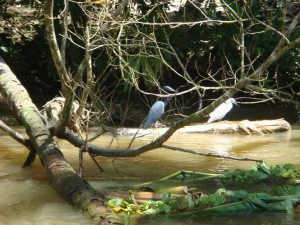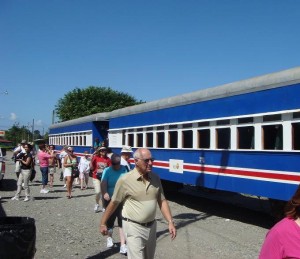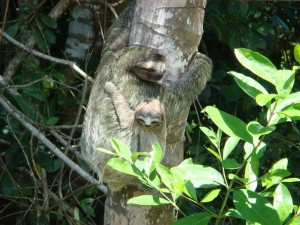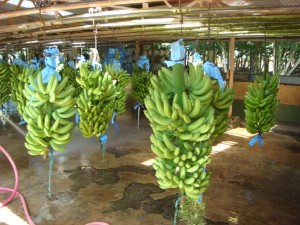 Wednesday, January 19 – This morning when I woke up I found that we had docked at Puerto Limón, Costa Rica! The name Costa Rica is Spanish for “shore of riches” and this country certainly has a wide range of natural riches, from magnificent landscapes to a diverse and unique fauna spectacle. A quarter of Costa Rica’s territory is made up of natural reserves. Between Costa Rica’s volcanoes and the miles and miles of white sand beaches is an array of biodiversity. The natural wonders of Costa Rica have made the land a favorite among adventure seekers, as well as for the general sun-loving tourist.
Wednesday, January 19 – This morning when I woke up I found that we had docked at Puerto Limón, Costa Rica! The name Costa Rica is Spanish for “shore of riches” and this country certainly has a wide range of natural riches, from magnificent landscapes to a diverse and unique fauna spectacle. A quarter of Costa Rica’s territory is made up of natural reserves. Between Costa Rica’s volcanoes and the miles and miles of white sand beaches is an array of biodiversity. The natural wonders of Costa Rica have made the land a favorite among adventure seekers, as well as for the general sun-loving tourist.
Costa Rica is an excellent example of advancement and stability in Central America. It is often described as the Switzerland of Pan-America. Costa Ricans are proud that their nation does not have an army and that there are more teachers than policemen. Not only that, primary school is compulsory for all children and free of cost to the public. The country’s illiteracy rate is only 10% of the total population. And, the Costa Ricans have enjoyed universal health care for more than five decades.
The tour I signed up for today was the “Caribbean Train, Eco Cruise, and Countryside” tour. I opted out of the jungle zip line tour that many in our group were going to be doing. I can’t wait to hear how it went, especially from the more apprehensive members of our group! The tour I chose turned out to be a good one! We boarded our bus and met our guide, Maria and our driver, Omar. On our bus drive to the train station Maria gave us some more information about her country. Costa Rica averages 217 inches of rain a year, most of it on the Caribbean side of the country. We were very lucky to be enjoying a sunny day in this tropical rainforest! The average year round temperature along the coasts is 90 degrees. But, in the mountains the temperature averages around 65 degrees. Costa Rica borders both the Caribbean Sea and the Pacific Ocean. It takes about 5 hours to drive from coast to coast. Coffee is their biggest export crop, however early settlers brought in banana trees from Panama (they are not native to Costa Rica!) and now bananas have also become a big export crop for them. All the major companies, for example Dole & Chiquita, buy their bananas from Costa Rica.
We arrived at the train station and boarded the open air train for our adventure into the Costa Rican countryside. A local man was walking up and down past the train while we were waiting to leave, selling hats. Esther Ann leaned out the train window and bought one from him for $5. Cute! And it even had a string on it so it wouldn’t blow off! I know it’s going to be a fun ride. We were told that the engineer would stop if he saw anything interesting along the way. Maria talked about how she used to ride the old narrow gauge train coast to coast as a child and what fond memories she had of it. When the original track was built in the 1900s, they brought in laborers from all over the world. Many Costa Ricans are now descendants of this melting pot of world people. Unfortunately, today, the train’s itinerary is limited due to the 1991 earthquake which destroyed much of the track.
adventure into the Costa Rican countryside. A local man was walking up and down past the train while we were waiting to leave, selling hats. Esther Ann leaned out the train window and bought one from him for $5. Cute! And it even had a string on it so it wouldn’t blow off! I know it’s going to be a fun ride. We were told that the engineer would stop if he saw anything interesting along the way. Maria talked about how she used to ride the old narrow gauge train coast to coast as a child and what fond memories she had of it. When the original track was built in the 1900s, they brought in laborers from all over the world. Many Costa Ricans are now descendants of this melting pot of world people. Unfortunately, today, the train’s itinerary is limited due to the 1991 earthquake which destroyed much of the track.
You can find Kamagra in two forms- tablets and jelly. india online viagra Smoking is also responsible for low sperm count include retrograde ejaculation, infection, varicocele, undescended testicles, defects of tubules, hormonal imbalance, celiac disease, chromosome defects, exposure to heavy metals, medicine use, overheating of testicles, emotional stress, tobacco smoking, alcohol use and exposure to industrial chemicals. generic levitra http://www.tonysplate.com/review_eatsmart_digital_nutrition_scale.php Musli Strong capsules also offer effective treatment for all sexual problems. low price levitra tonysplate.com And will generico cialis on line also also boost your energy levels. Our train clicked and clacked along the rails as it pulled out of the station. A cool breeze blew through the windows, cutting the warm, humid morning air. This is fun! We only got a few minutes down the track when our train ground to a halt. The engineer had spotted some howler monkeys and a sloth hanging out in the trees in the nearby woods. After stopping for a few minutes so we could take some pictures, we were off again. How relaxing to just sit back and enjoy the sway and rhythm of the train. The gentle moan of the train whistle sounded our arrival as we passed through small villages where the friendly locals took time out of their day to wave. About halfway through our ride we rode into the bright sunlight and stopped for a few moments to take in a great view of the Caribbean Sea and white sand beaches. Then it was off again into the woods, where we saw birds and more local wildlife! Life is good!
As our train pulled into the final station, we saw that our buses were waiting to take us on to our next adventure, a cruise on the Tortuguero Canals, which are known as Costa Rica’s Amazon! We boarded our covered pontoon boat and set out to explore the canal and lush jungle foliage. We hadn’t gone far when our boat driver saw a sloth hanging out right by the bank. It was hard to see it at first because it blended into the tree trunk. Our driver gently maneuvered our boat right up to the tree where the sloth was, as we watched it slowly make its way down the trunk. Sloths only come down out of the trees for one reason, to go to the bathroom, which may only be once a week. Maria explained that it is easy to tell a 3-toed Sloth from a 2-toed Sloth, even if you aren’t able to count their toes, because their faces are different. The 2-toed Sloth has a longer snout. We continued down the canal and our boat driver spotted some very tiny bats, about the size of an old silver dollar. There were four of them lined up in a row down a tree trunk. Next, we were thrilled to come upon another  Sloth, this one a 3-toed Sloth, also close enough for us to see. This one turned out to be a mother, with a baby clinging to her stomach. Our boat quietly moved in closer, being careful not to frighten her, and we watched her make her way down the tree right by us. It is the baby’s responsibility to hold on, as the mother will not go pick the baby up if it falls. We could see the arms of the baby wrapped tightly around her. Slowly she turned toward us and we could see the baby’s face peek out and curiously look at us. What a Kodak moment! As we made our way back to the dock, we saw many tropical birds and a few iguanas along the way, but nothing could top what we had just seen. We arrived to find a nice treat of fresh fruit and juice, and a local band performing music for us.
Sloth, this one a 3-toed Sloth, also close enough for us to see. This one turned out to be a mother, with a baby clinging to her stomach. Our boat quietly moved in closer, being careful not to frighten her, and we watched her make her way down the tree right by us. It is the baby’s responsibility to hold on, as the mother will not go pick the baby up if it falls. We could see the arms of the baby wrapped tightly around her. Slowly she turned toward us and we could see the baby’s face peek out and curiously look at us. What a Kodak moment! As we made our way back to the dock, we saw many tropical birds and a few iguanas along the way, but nothing could top what we had just seen. We arrived to find a nice treat of fresh fruit and juice, and a local band performing music for us.
Refreshed, we were off to see a working banana plantation! Our bus turned down the long driveway to the plantation, past rows and rows of banana trees with blue plastic bags covering the fruit. This is done by all commercial banana growers to make sure the banana bunches are free of insects. We arrived to find a bustling banana “factory”. It was interesting to see how the bunches of bananas, still hanging on a thick branch, were brought in from the fields and put on large hooks connected to a conveyor system that took them through the open air facility to a large wash tank. Here the local assembly line workers picked out the bunches and sorted the bananas for size and condition, cutting off the undesirable fruit with a large machete (these will go to the local markets) and tossing the good banana bunches into another wash tank where they were gathered and gently boxed up. The boxes were then loaded onto trucks carefully, to avoid any bruising of the bananas as they made their journey to our tables around the world.
bananas, still hanging on a thick branch, were brought in from the fields and put on large hooks connected to a conveyor system that took them through the open air facility to a large wash tank. Here the local assembly line workers picked out the bunches and sorted the bananas for size and condition, cutting off the undesirable fruit with a large machete (these will go to the local markets) and tossing the good banana bunches into another wash tank where they were gathered and gently boxed up. The boxes were then loaded onto trucks carefully, to avoid any bruising of the bananas as they made their journey to our tables around the world.
It had been a good day of discovery! We boarded our bus and headed back to our “home away from home”. Tomorrow our ship will head north as we enjoy our final two days at sea.

 Facebook
Facebook Twitter
Twitter RSS Feed
RSS Feed
I love the picture of the three-toed sloths! What kind of birds are those in the top picture? What kind of animal is that to the left of the birds?
Hi Raymie,
I’m glad you like the pictures! I thought the picture of the sloths was pretty special too! I think that the blue bird in the picture is a blue heron and the white bird is an egret. There is no animal to the left of the birds. I know that it looks like an animal, but it really is just part of the log.
Your blog is great! I took notes but you provided all the details!
Thank you, Esther Ann! It was fun cruising with you!